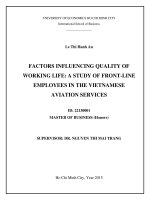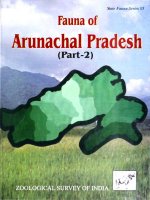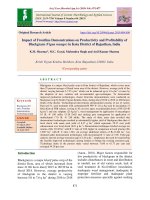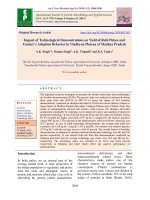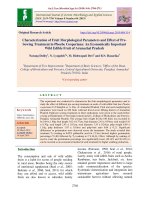Impact analysis of trainings and front line demonstrations in black gram (Vigna mungo) cultivation of Tirap district of Arunachal Pradesh
Bạn đang xem bản rút gọn của tài liệu. Xem và tải ngay bản đầy đủ của tài liệu tại đây (265.19 KB, 6 trang )
Int.J.Curr.Microbiol.App.Sci (2019) 8(9): 2881-2886
International Journal of Current Microbiology and Applied Sciences
ISSN: 2319-7706 Volume 8 Number 09 (2019)
Journal homepage:
Original Research Article
/>
Impact Analysis of Trainings and Front Line Demonstrations in Black
Gram (Vigna mungo) Cultivation of Tirap district of Arunachal Pradesh
Abhimanyu Chaturvedi1*, Shashikant Chaturvedi2, Neha Sharma3,
T. S. Mishra4 and Shailendra Vikram Singh5
1
2
Krishi Vigyan Kendra Tirap, Deomali, Arunachal Pradesh, India
Krishi Vigyan Kendra Lower Subansiri,Yachuli, Arunachal Pradesh, India
3
Krishi Vigyan Kendra Sagar, Madhya Pradesh, India
4
KVK West Kameng, Arunachal Pradesh, India
5
S.D.J.P.G.College- Chandeshwer-Azagmarh, Uttar Pradesh, India
*Corresponding author
ABSTRACT
Keywords
Adoption,
Integrated pest
management,
integrated nutrient
management,
Technology index
Article Info
Accepted:
25 August 2019
Available Online:
10 September 2019
The impact assessment for upgraded knowledge levels of farmers regarding
scientific package of practices, extent of adoption of selected technology
and percent adoption of production technology was carried out in 05
adopted villages. The data showed that Overall farmers knowledge level
increased 8 (low level), 52 (medium level) and 28 (high level) per cent,
respectively after intervention of Krishi Vigyan Kendra. The maximum
knowledge regarding different scientific innovations was found for cultural
practices (48%), weed management (41%), integrated nutrient management
(35%) pest and disease management (32 %) and pest, IPM (2 %),
respectively. The technology index depicted that there was feasibility of
evolving technologies at the farmer’s field.
Introduction
Black gram (Vigna mungo) is a widely grown
pulse crop, belongs to the family fabaceae and
having good importance for food and
nutritional security in the world. Due to short
duration crop; by nature and survivalist in all
seasons either as sole or as intercrops. India is
the world’s largest producer as well as
consumer of black gram. It produces about
1.5–1.9 MT of black gram annually from
about 3.5 m ha of area, with an average
productivity of 600 kg/ha. Black gram shares
about 10 per cent of India’s total pulse
production. Therefore, it is necessary to assess
the technological gap in production and also to
know the problems and constraints in adopting
modern black gram production technologies;
Islam et al., (2011). Keeping all these in mind,
the present investigation was carried out to
2881
Int.J.Curr.Microbiol.App.Sci (2019) 8(9): 2881-2886
find out the current knowledge level of black
gram producers with following points:
adoption scale of improved practices, yield
gap etc.
KVK through different training programmes,
kisan gosthis, field visits and front line
demonstrations (FLDs) (Table 1). The similar
findings reported by earlier researchers: Javat
et al., (2011) and Das et al., (2010).
Materials and Methods
The present study was conducted in Tirap
district of Arunachal Pradesh during Kharif
season of 2017-18. Twenty five farmers from
5 villages viz., Noitong, Nutan Basti, Lekhi
Basti, Makat and Doidam were selected. The
data were collected through personnel
interview, tabulated and analyzed to find out
the findings and draw the conclusion. The
statistical tool like percentage was employed
to analyze the data.
The constraints as perceived by respondents
were scored on the basis of magnitude of the
problem as per Meena and Sisodiya (2004).
The responses were recorded and converted in
to mean per cent score and ranked accordingly
as per Warde et al.,(1991). The extension gap,
technology gap and the technology index were
work out with the help of formulas given by
Samui et al., (2000) as mentioned below:
Extension gap = Demonstration
farmers’ yield (control)
Technology
gap
=
Potential
demonstration yield
yield-
In respect to different aspects of scientific
cultivation of black gram; the total 48 % of
farmers were possessing high level of
knowledge regarding cultural practice
followed by weed management (41%),
integrated nutrient management (35 %). While
the minimum knowledge were possessed
about IPM (25 %) and pest, disease control
(32 %) (Table 2).
Before intervention of the KVK, the total 48%
of farmers had medium level of knowledge;
which was drastically changed after
intervention of KVK (71 per cent of the
farmers had high level of knowledge regarding
scientific cultivation of black gram) (Table 3).
In the case of adoption per cent of different
technologies; the Cultural practices segment
scored highest adoption percentage (64%)
followed by pest and disease control (59%),
IPM (56%) respectively, while the minimum
adoption per cent was recorded with INM
(47%) followed by Weed management (53%)
(Table 4).
yieldYield gap analysis of black gram cultivation
Technology index
Technology gap
=----------------------- x100
Potential Yield
Results and Discussion
The result revealed that the overall knowledge
about black gram cultivation before
intervention by the KVK was 44, 38, 9 per
cent (low, level, medium level high level),
respectively which was positively changed up
to 08, 52 and 28 per cent, after intervention of
Table 5 clearly showing that the maximum
yield (7.76 q/ha) was reported in FLD plots
and minimum yield (5.4 q/ha) under farmers’
plots. The cost benefit ratio was higher in FLD
plot (1:3.35) than control (1: 2.48). These
findings are clearly showing that due to
knowledge and adoption of scientific
practices, the yield of black gram could be
increased by 37 per cent, 19 per cent and 40
per cent over the yield obtained under
farmers’ practices. These findings are
supported by findings of Dubey et al., (2010).
2882
Int.J.Curr.Microbiol.App.Sci (2019) 8(9): 2881-2886
Table.1Overall knowledge of scientific package of practices of blackgram.
Category
Before intervention of KVK
After intervention of KVK
Low level of knowledge
44
08
Medium level of knowledge
High level of knowledge
38
9
52
28
Table.2 Knowledge regarding different technologies for black gram cultivation.
Sr.
Technology
Low
Medium
High
1
2
3
4
5
Cultural Practices
Pest and disease control
Integrated pest management
Weed management
Integrated nutrient management
36
25
34
21
26
16
43
41
38
39
48
32
25
41
35
Table.3 Overall adoption of scientific package of practices of blackgram (percentage)
Category
Before intervention of KVK
After intervention of KVK
26
48
26
7
22
71
Low level of knowledge
Medium level of knowledge
High level of knowledge
Table.4 Adoption of Technologies
S.No.
1
2
3
4
5
Name of Technology
Cultural practices
Pest & Disease management
Integreted Pest Management
Weed management
Integreted Nutrient Management
Adoption %
64
59
56
53
47
Table.5 Productivity, Yield gaps and Technology Index of Black gram
Year
2016
2017
2018
Area
(ha)
No of
Demos.
10
24
10
25
10
25
Average
Yield (q/ha)
Demos Control
6.58
7.93
8.77
7.76
4.80
6.39
5.26
5.48
Per cent
Increase
in yield
37
19
40
32
B:C ratio
Demos Control
Extension
gap (q/ha)
Technology
gap (q/ha)
Technology
Index
3.26
2.96
3.84
3.35
1.78
1.54
3.51
2.27
3.24
1.89
1.05
2.06
32.99
19.24
10.69
20.97
2883
2.67
2.48
2.30
2.48
Int.J.Curr.Microbiol.App.Sci (2019) 8(9): 2881-2886
2884
Int.J.Curr.Microbiol.App.Sci (2019) 8(9): 2881-2886
The yield of the front line demonstration trials
and potential yield of the crop was compared
to estimate the yield gaps which were further
categorized into technology and extension
gaps (Hiremath and Nagaraju, 2009).
The average extension gap was 2.27 q/ha,
which indicates the better and intensive
education of farmers through different means
like FLD, trainings, kisan gosthi, field visits
etc. The average technology gap was 2.06 q/ha
(ranged between 1.05 q/ha to 3.24 q/ha). The
average technology gap from three year of
FLDs programme was 25q/ ha. The variation
of technology gap observed may be soil
fertility status, followed agricultural practices
and micro climatic conditions.
Technology index showed that huge gap
between farmer’s field and demonstration
field. There are huge scopes of scientific
technologies at the farmer field. Lower the
value of technology index, more is the
feasibility of technology demonstrated, (Sagar
and Chandra, 2004; Arunachalam, 2011 and
Kumar et al., 2014).
Haque (2000), Mishra et al., (2009) and
Kumar et al., (2010).
The FLD proved a significant positive results
with motivation to researcher for further
demonstration of productivity potential and
profibility at farmers field. Similar finding
were reported by Kirar et al., (2005) and
Chauhan and Pandya (2012) in gram.
The scientific knowledge level and adoption
level of different technologies on black gram
cultivation were positively changed; in five
adopted villages after imparting training, FLD,
kisan gosthi, field visits, by KVK scientists in
Tirap district of Arunachal Pradesh.
The higher productivity recorded under FLD
over farmers practices created awareness and
also encouraged the other farmers to adopt
scientific know how for blackgram cultivation
e.i., cultural practices, integrated pest
management, integrated nutrient management,
integrated weed management etc. in the
district.
Acknowledgement
The reduction of technology index from 32.99
per cent (2016) to 10.69 per cent (2018)
exhibited the feasibility of technology
demonstrated.
Similarly,
the
yield
enhancement in different crops in front line
demonstration has amply been documented by
Krishi Vigyan Kendra, Tirap is thankful to the
Director, ICAR-ATARI, Zone-VI, Guwahati
for providing funds for conducting the CFLDs
and farmers who always show faith in the
Krishi Vigyan Kendra.
2885
Int.J.Curr.Microbiol.App.Sci (2019) 8(9): 2881-2886
References
Arunachalam R (2011). Spread and
acceptance of recommended production
technologies in green gram and black
gram: a comparative analysis. Legume
Res - An Int J 34(1):8-13
Chauhan N M and Pandya C D (2012).
Impact and yield crack analysis of
trainings and FLDs regarding scientific
practices of Gram. Agric Update 7(3&4):
199-202.
Das Mamoni, Puzari N N and Ray B K
(2010).Impact of training of skill and
knowledge development of rural women.
Agric Extn Rev 1(1): 29-30.
Dubey S, Tripathi S, Singh P and Sharma R K
(2010). Yield gap analysis of black gram
production
through
frontline
demonstration. J Prog Agric 1(1): 42-44.
Haque M S (2000). Impact of compact block
demonstration on increase in productivity
of rice. Maharashtra J Extn Edu 19 (1):
22-27.
Hiremath S M and Nagaraju M V (2009).
Evaluation of front line demonstration
trials on onion in Haveri district of
Karnataka. Karnataka J Agric Sci 22
(5):1092-1093
Islam M, Mohanty A K and Kumar S (2011).
Correlation growth yield and adoption of
urdbean technologies. Indian Res J Ext
Edu 11 (2): 20-24.
Javat H, Patel M M, Kumar K S and Saxena
A(2011).Impact
of
front
line
demonstrations on scientific temperament
of wheat growers Rajasthan J Extn Edu.
17-18:115- 117.
Kirar B S, Mahajan S K, Nshine R, Awasthi H
K and Shukla R N (2005). Impact of
technological
practices
on
the
productivity of soybean in front line
demonstration. Indian Res J Extn Edu 5
(1):15-17.
Kumar A, Kumar R, Yadav V P S and Kumar
R (2010). Impact assessment of Frontline
demonstrations of Bajra in Haryana State.
Indian Res J Extn Edu 10(1): 105-108.
Kumar S, Singh R and Singh A (2014).
Assessment of gaps in pulse production in
Hamipur district of Himachal Pradesh.
Indian Res J Ext Edu 14 (2): 20-24
Meena S R and Sisodiya S S (2004).
Constraints as perceived by the
respondents in adoption of recommended
guava production technology. Rajasthan J
Extn Edu 12-13:146- 153.
Mishra D K, Paliwal D K, Tailor R S and
Deshwal A K (2009). Impact of Frontline
demonstrations on yield enhancement of
potato. Indian Res J Extn Edu 9 (3): 2628.
Sagar R L and Chandra G (2004). Frontline
demonstration on sesame in West Bengal.
Agric Extn Rev 16 (2):7-10.
Samui S K, Maitra S, Roy D K, Mandal A K
and Saha D (2000). Evaluation of
frontline demonstration on groundnut. J
Indian Soc Costal Agric Res 18 (2):180183.
Warde P N, Bhope R S and Chudhary D P
(1991). Adoption of dry land horticulture
technology. Maharastra J Extn Edu 10
(2): 108-111.
How to cite this article:
Abhimanyu Chaturvedi, Shashikant Chaturvedi, Neha Sharma, T. S. Mishra and Shailendra
Vikram Singh 2019. Impact Analysis of Trainings and Front Line Demonstrations in Black
Gram (Vigna mungo) Cultivation of Tirap district of Arunachal Pradesh.
Int.J.Curr.Microbiol.App.Sci. 8(09): 2881-2886. doi: />
2886



